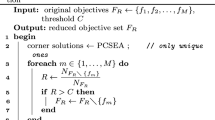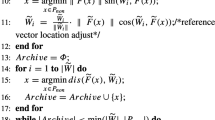Abstract
In recent years, many-objective optimization problems (i.e. more than three objectives) have attracted the interests of many researchers. The main difficulties of many-objective optimization problems lie in high computational cost, stagnation in search process, etc. It is almost impossible to design an algorithm effective for all problems. However, for some problems, especially for problems with redundant objectives, it is possible to design effective algorithms by removing the redundant objectives and keeping the non-redundant objectives so that the original problem becomes the one with much fewer objectives. To do so, first, a multi-objective evolutionary algorithm-based decomposition is adopted to generate a smaller number of representative non-dominated solutions widely distributed on the Pareto front. Then the conflicting objective pairs are identified through these non-dominated solutions, and the redundant objectives are determined by these pairs and then removed. Based on these, a fast non-redundant objectives generation algorithm is proposed in this paper. Finally, the experiments are conducted on a set of benchmark test problems and the results indicate the effectiveness and efficiency of the proposed algorithm.




Similar content being viewed by others
References
Brockhoff D, Zitzler E (2006) Are all objectives necessary? On dimensionality reduction in evolutionary multiobjective optimization. In: Conference on parallel problem solving from nature, 533–542
Brockhoff D, Zitzler E (2006) Dimensionality reduction in multi-objective optimization with (partial) dominance structure preservation: generalized minimum objective subset problems. TIK-Report
Brockhoff D, Zitzler E (2009) Objective reduction in evolutionary multi-objective optimization: theory and applications. Evol Comput 17(2):135–166
Cheung Y, Gu F (2014) Online objective reduction for many-objective optimization problems, IEEE Congress on evolutionary computation (CEC2014), 1165–1171
Deb K, Agrawal S, Pratap A, Meyarivan T (2002) A fast and elitist multi-objective genetic algorithm: NSGA-II. IEEE Trans Evol Comput 6(2):182–197
Deb K, Saxena D (2005) On finding pareto-optimal solutions through dimensionality reduction for certain large-dimensional multi-objective optimization problems, Kangal Technique report
Deb K, Thiele L, Laumanns M, Zitzler E (2002) Scalable multi-objective optimization test problems, In: Proceedings of congress evolutionary computation, vol 1, pp 825–830
di Pierro F, Khu S-T, Savi’c DA (2007) An investigation on preference order ranking scheme for multi- objective evolutionary optimization. IEEE Trans Evol Comput 11(1):17–45
Emmerich M, Beume N, Naujoks B (2005) An EMO algorithm using the hypervolume measure as selection criterion, conference on evolutionary multi-criterion optimization, Springer, Heidelberg, pp 62–76
Farina M, Amato P (2002) On the optimal solution definition for many-criteria optimization problems. In: Proceedings of the NAFIPS-FLINT international conference 2002, Piscataway, pp 233–238
Gu L, Yang RJ, Tho CH, et al (2012) Optimization and robustness for crashworthiness of side impact. Int J Veh Des. doi:10.1504/IJVD.2001.005210
Huband Simon et al (2005) A scalable multi-objective test problem toolkit. Evol Multi-Criterion Optim Lect Notes Comput Sci 3410:280–295
Huband S, Hingston P, Barone L, While L (2006) A review of multi-objective test problems and a scalable test problem toolkit. IEEE Trans Evol Comput 10(5):477–506
Ishibuchi H, Tsukamoto N, Nojima Y (2008) Evolutionary many-objective optimization: a short review, In: CEC 2008, Hong Kong, pp 2424–2431
Jaimes AL, Coello CAC, Chakraborty D (2008) Objective reduction using a feature selection technique. In: Proceedings of genetic and evolutionary computation conference (GECCO), pp 673–680
Jaimes AL, Coello CA, Barrientos JEU (2009) Online objective reduction to deal with many-objective problems. In: Proceedings of evolutionary multi-criterion optimization, pp 423–437
Koppen M, Yoshida K (2007) Substitute distance assignment in NSGAII for handing many-objective optimization problems. In: Proceedings of evolutionary multi-criterion optimization, pp 727–741
Kruisselbrink JW, Emmerich MT et al. (2009) Combining aggregation with Pareto optimization: a case study in evolutionary molecular design. In: Proceeding of evolutionary multi-criterion optimization, pp 453–467
Laumanns M, Thiele L, Deb K (2002) Combining convergence and diversity in evolutionary many-objective optimization. Evol Comput 10(3):263–282
Murata T, Taki A (2009) Many-objective optimization for knapsack problems using correlation-based weight sum approach. In: Proceeding of evolutionary multi-criterion optimization, pp 468–480
Musselman K, Talavage J (1980) A trade-off cut approach to multiple objective optimization. Oper Res 28(6):1424–1435
Purshouse RC (2003) Evolutionary many-objective optimisation: an exploratory analysis. In: Proceedings of the 2003 congress on evolutionary computation, Canberra, pp 2066–2073
Purshouse Robin C, Fleming Peter J (2003) Conflict, harmony, and independence: relationships in evolutionary multi-criterion optimization, In: Proceedings of EMO, pp 16–30
Sato H, Aguirre HE, Tanaka K (2007) Controlling dominance area of solutions and its impact on the performance of MOEAs. Evol Multi-Criterion Optim Lect Notes Comput Sci 4403:5–20
Saxena DK, Deb K (2013) Objective reduction in many-objective optimization: linear and nonlinear algorithm. IEEE Trans Evol Comput 17(1):77–98
Singh HK (2011) A pareto corner search evolutionary algorithm and dimensionality reduction in many-objective optimization problems. IEEE Trans Evol Comput 15(4):539–556
Su Y, Lihong X (2013) Dimensionality reduction based on geometric projection for many-objective optimization. Control Decis 28(8):1173–1177
Wang R (2013) Preference-inspired co-evolutionary Algorithms. PhD thesis, University of Sheffield
yan Tan Y, chang Jiao Y, Li H, kuan Wang X (2013) MOEA/D + uniform design: a new version of MOEA/D for optimization problems with many objectives. Comput Oper Res 40(6):1648–1660
Yang S, Li M, Liu X (2013) A grid-based evolutionary algorithm for many-objective optimization. IEEE Trans Evol Comput 17(5):721–736
Zhang Q, Li H (2007) MOEA/D: a multiobjective evolutionary algorithm based on decomposition. IEEE Trans Evol Comput 11(6):712–731
Zhou C, Zheng J, Li Ke et al(2009) Objective reduction based on the least square method for large-dimensional multi-objective optimization problem. In: Proceedings of of 5th International conference on natural computation, pp 350–354
Zitzler E, Brockhoff D, Thiele L (2007) The hypervolume indicator revisited: on the design of pareto-compliant indicators via weighted integration, conference on evolutionary multi-criterion optimization, pp 862–876
Zitzler E, Künzli S (2004) Indicator-based selection in multiobjective search. Conference on parallel problem solving from nature, pp 832–842
Zitzler E, Laumanns M, Thiele L (2003) SPEA2: improving the strength Pareto evolutionary algorithm for multiobjective optimization, In: Proceedings of evolutionary methods for design optimization and control with applications to industrial problems, Greece, pp 95–100
Zou X, Chen Y, Liu M (2008) A new evolutionary algorithm for solving many-objective optimization problems. IEEE Trans Syst Man Cybern 38(5):1402–1412
Acknowledgments
This work was supported by the National Natural Science Foundations of China (Nos. 61472297, 61272119, 61402350), the Nature Science Foundation of Shaanxi Province (No. 2013JM1007), and the Principle Foundation of Xi’an Technological University (No. XAGDXJJ1232). The authors would like to thank the anonymous reviewers for their valuable comments and suggestions.
Author information
Authors and Affiliations
Corresponding author
Additional information
Communicated by V. Loia.
Rights and permissions
About this article
Cite this article
Guo, X., Wang, Y. & Wang, X. An objective reduction algorithm using representative Pareto solution search for many-objective optimization problems. Soft Comput 20, 4881–4895 (2016). https://doi.org/10.1007/s00500-015-1776-4
Published:
Issue Date:
DOI: https://doi.org/10.1007/s00500-015-1776-4




